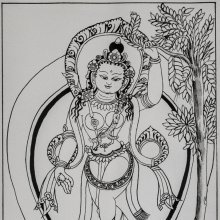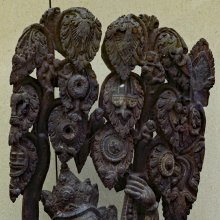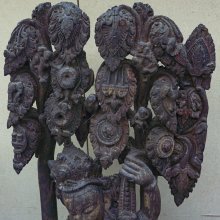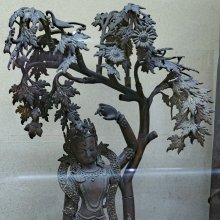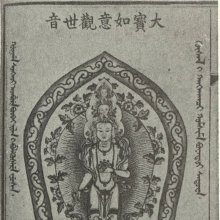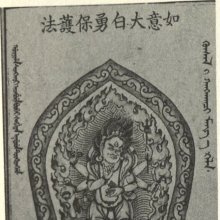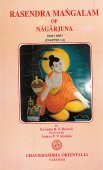Cintamani, Cintāmaṇi, Cintāmanī, Cinta-mani, Cimtamani: 35 definitions
Introduction:
Cintamani means something in Buddhism, Pali, Hinduism, Sanskrit, Jainism, Prakrit, Marathi, Tamil. If you want to know the exact meaning, history, etymology or English translation of this term then check out the descriptions on this page. Add your comment or reference to a book if you want to contribute to this summary article.
Alternative spellings of this word include Chintamani.
Images (photo gallery)
(+7 more images available)
In Hinduism
Shilpashastra (iconography)
Source: Red Zambala: Hindu Icons and Symbols | IntroductionCintāmaṇi (Wish-fulfilling gem) - Represents the mind, the precious jewel of the perfected mind in which all wishes and aims are accomplished.

Shilpashastra (शिल्पशास्त्र, śilpaśāstra) represents the ancient Indian science (shastra) of creative arts (shilpa) such as sculpture, iconography and painting. Closely related to Vastushastra (architecture), they often share the same literature.
Purana and Itihasa (epic history)
Source: Wisdom Library: Skanda-puranaCintāmaṇi (चिन्तामणि, “taker of worries”) refers to one of the fifty-six vināyakas located at Kāśī (Vārāṇasī), and forms part of a sacred pilgrimage (yātrā), described in the Kāśīkhaṇḍa (Skanda-purāṇa 4.2.57). He is also known as Cintāmaṇivināyaka, Cintāmaṇigaṇeśa and Cintāmaṇivighneśa. These fifty-six vināyakas are positioned at the eight cardinal points in seven concentric circles (8x7). They center around a deity named Ḍhuṇḍhirāja (or Ḍhuṇḍhi-vināyaka) positioned near the Viśvanātha temple, which lies at the heart of Kāśī, near the Gaṅges. This arrangement symbolises the interconnecting relationship of the macrocosmos, the mesocosmos and the microcosmos.
Cintāmaṇi is positioned in the North-Western corner of the fourth circle of the kāśī-maṇḍala. According to Rana Singh (source), his shrine is located at “Ishwargangi Talab, Ausanganj, K 56 / 43H”. Worshippers of Cintāmaṇi will benefit from his quality, which is defined as “the taker of all worries from the devotees”. His coordinates are: Lat. 25.19490, Lon. 83.00521 (or, 25°11'41.6"N, 83°00'18.8"E) (Google maps)
Cintāmaṇi, and the other vināyakas, are described in the Skandapurāṇa (the largest of the eighteen mahāpurāṇas). This book narrates the details and legends surrounding numerous holy pilgrimages (tīrtha-māhātmya) throughout India. It is composed of over 81,000 metrical verses with the core text dating from the before the 4th-century CE.
Source: archive.org: Puranic EncyclopediaCintāmaṇi (चिन्तामणि).—A diamond. This was salvaged from the ocean of milk along with other precious items like Airāvata, Uccaiḥṣravas, Kalpavṛkṣa, Kaustubha, Candra, Apsaras, Mahālakṣmī, Tārā, and Rumā. (Yuddha Kāṇḍa, Kaṃpa Rāmāyaṇa).

The Purana (पुराण, purāṇas) refers to Sanskrit literature preserving ancient India’s vast cultural history, including historical legends, religious ceremonies, various arts and sciences. The eighteen mahapuranas total over 400,000 shlokas (metrical couplets) and date to at least several centuries BCE.
Vyakarana (Sanskrit grammar)
Source: Wikisource: A dictionary of Sanskrit grammarCintāmaṇi (चिन्तामणि).—Name of a commentary on the Sutras of the Sakatayana Vyakarana written by यक्षवर्मन् (yakṣavarman), It is also called लधुवृत्ति (ladhuvṛtti).

Vyakarana (व्याकरण, vyākaraṇa) refers to Sanskrit grammar and represents one of the six additional sciences (vedanga) to be studied along with the Vedas. Vyakarana concerns itself with the rules of Sanskrit grammar and linguistic analysis in order to establish the correct context of words and sentences.
Chandas (prosody, study of Sanskrit metres)
Source: Shodhganga: a concise history of Sanskrit Chanda literature1) Cintāmaṇi (चिन्तामणि) or Cintāmaṇi Daivajña (17th century) alias Cintāmaṇi Jyotirvid, composer of Prastāracintāmaṇi and other texts, was the son of Govinda Jyotirvid of Śivapura of Gārgyagotra and a contemporary of Shah Jehan. He was the grandson of Nīlakaṇṭha and great grandson of Ananta. Cintāmaṇi mentions about the scholarship of his ancestors and himself in the end of his commentary on Vṛttaratnākara. He says: “His grandfather Nīlakaṇṭha was well versed in all śāstras and resided in Vārāṇasī, his father Govinda was praised by the kings and well versed in Astrology. Then he tells about himself that he was scholar with numerous credibility as he was an excellent commentator (vyākhyānavidvattama), exponent in literature, knower of jyotiṣa”.
2) Cintāmaṇi (चिन्तामणि) (19th century), son of Jīva, and the chief court astrologer in the princely state of Kohlāpur; now in Mahārāṣṭra composed a text on prosody namely Chandaḥsāra. He belongs to Śāṇḍilyagotra. He flourished during the reign of King Sāhuji, son of Śivajī and fifth descendant of Śivājī in Kohlāpur. He was well versed in logic, literature, etc. He mentions about this in the beginning of his work Śyāmalābhāṇa, which was composed during the reign of Sāhujī.

Chandas (छन्दस्) refers to Sanskrit prosody and represents one of the six Vedangas (auxiliary disciplines belonging to the study of the Vedas). The science of prosody (chandas-shastra) focusses on the study of the poetic meters such as the commonly known twenty-six metres mentioned by Pingalas.
Ayurveda (science of life)
Rasashastra (Alchemy and Herbo-Mineral preparations)
Source: Wisdom Library: Rasa-śāstraCintāmaṇi (चिन्तामणि) is the name of an Ayurvedic recipe defined in the fourth volume of the Rasajalanidhi (chapter 2, dealing with jvara: fever). These remedies are classified as Iatrochemistry and form part of the ancient Indian science known as Rasaśāstra (medical alchemy). However, as an ayurveda treatment, it should be taken twith caution and in accordance with rules laid down in the texts.
Accordingly, when using such recipes (e.g., cintāmaṇi-rasa): “the minerals (uparasa), poisons (viṣa), and other drugs (except herbs), referred to as ingredients of medicines, are to be duly purified and incinerated, as the case may be, in accordance with the processes laid out in the texts.” (see introduction to Iatro chemical medicines)
Toxicology (Study and Treatment of poison)
Source: Shodhganga: Kasyapa Samhita—Text on Visha ChikitsaCintāmaṇi (चिन्तामणि) or Cintāmaṇimantra is the name of a Mantra, as described in the Kāśyapa Saṃhitā: an ancient Sanskrit text from the Pāñcarātra tradition dealing with both Tantra and Viṣacikitsā—an important topic from Āyurveda which deals with the study of Toxicology (Viṣavidyā or Sarpavidyā).

Āyurveda (आयुर्वेद, ayurveda) is a branch of Indian science dealing with medicine, herbalism, taxology, anatomy, surgery, alchemy and related topics. Traditional practice of Āyurveda in ancient India dates back to at least the first millenium BC. Literature is commonly written in Sanskrit using various poetic metres.
Vaishnavism (Vaishava dharma)
Source: Pure Bhakti: Brhad BhagavatamrtamCintāmaṇi (चिन्तामणि) refers to:—Wish-fulfilling gem. (cf. Glossary page from Śrī Bṛhad-bhāgavatāmṛta).

Vaishnava (वैष्णव, vaiṣṇava) or vaishnavism (vaiṣṇavism) represents a tradition of Hinduism worshipping Vishnu as the supreme Lord. Similar to the Shaktism and Shaivism traditions, Vaishnavism also developed as an individual movement, famous for its exposition of the dashavatara (‘ten avatars of Vishnu’).
Shaktism (Shakta philosophy)
Source: Google Books: ManthanabhairavatantramCintāmaṇi (चिन्तामणि) refers to the “wish-granting gem”, according to the Manthānabhairavatantra, a vast sprawling work that belongs to a corpus of Tantric texts concerned with the worship of the goddess Kubjikā.—Accordingly, while describing the visualization of Koṅkaṇā: “She is the most excellent of the supreme, Parā, the goddess of the Kaula of the Command of Knowledge. (She is) the wish-granting gem [i.e., cintāmaṇi] of sovereign power (śrī). (Her) weapons are a bow and wheel; she has a sword and an axe, and holds a goad and a noose. She is the unfailing Koṅkaṇā, the Kaula Weapon (who holds a) bow, arrow, club, thunderbolt, and javelin. (She has big) fang-like teeth. [...]”.
Source: Brill: Śaivism and the Tantric Traditions (shaktism)Cintāmaṇi (चिन्तामणि) refers to “wish-fulfilling jewels”, according to the Devīpurāṇa verse 88.1-3.—Accordingly, “People desiring liberation worship the Mothers by way of the Vedas and the Śaiva Tantric revelation. They are also worshipped in accordance with the Gāruḍatantras, Bhūtatantras, and Bālatantras. Beneficent, they bring all endeavors to fruition, and are like wish-fulfilling jewels (cintāmaṇi). Heretics of the future—[viz.] the Buddhist proponents of Gāruḍa Tantra—will worship them according to their own methods, devoted to their own ways, dear child. They give rewards that accord with any disposition wise people worship them with, whether they be Brahmins or even lowborn outcastes”.

Shakta (शाक्त, śākta) or Shaktism (śāktism) represents a tradition of Hinduism where the Goddess (Devi) is revered and worshipped. Shakta literature includes a range of scriptures, including various Agamas and Tantras, although its roots may be traced back to the Vedas.
Shaivism (Shaiva philosophy)
Source: SOAS University of London: Protective Rites in the Netra TantraCintāmaṇi (चिन्तामणि) refers to “splendid gems”, according to the Netratantra of Kṣemarāja: a Śaiva text from the 9th century in which Śiva (Bhairava) teaches Pārvatī topics such as metaphysics, cosmology, and soteriology.—Accordingly, [verse 9.5-11, while explaining the universality of Amṛteśa]—“[...] Thus, in this way, Deveśa [is found in all] Āgamas. He gives of all Sādhakas the benefits [of worship] from all directions [i.e., no matter what their tradition]. Because of him, splendid gems light up (cintāmaṇi—cintāmaṇir ivojjvalaḥ) [differently] under different conditions, giving the fruits of all āgamas in all streams. Thus, he is Śiva, Sadāśiva, Bhairava, Tumburu, Soma, and Sūrya, with his own form arising bearing no form”.

Shaiva (शैव, śaiva) or Shaivism (śaivism) represents a tradition of Hinduism worshiping Shiva as the supreme being. Closely related to Shaktism, Shaiva literature includes a range of scriptures, including Tantras, while the root of this tradition may be traced back to the ancient Vedas.
Yoga (school of philosophy)
Source: ORA: Amanaska (king of all yogas): A Critical Edition and Annotated Translation by Jason BirchCintāmaṇi (चिन्तामणि) refers to the “wish-fulfilling gem”, according to the Brahmayāmala-tantra (or Picumata), an early 7th century Śaiva text consisting of twelve-thousand verses.—Accordingly, [while describing a haṭha-sādhana (foreceful practice)]: “[...] On the eighth day, the Sādhaka sees the shadow of Aghorī. Thus content, she gives [a boon, saying to the Sādhaka], ‘Good, my dear! Choose a boon: either lord of the earth, immortality, levitation, [entry into the] nether-worlds, coming and going through the sky, invisibility, the elixir of mercury, the wish-fulfilling gem (cintāmaṇi), the [magical] sword, the [seven-league] sandals or the [occult] eye collyrium’ [...]”

Yoga is originally considered a branch of Hindu philosophy (astika), but both ancient and modern Yoga combine the physical, mental and spiritual. Yoga teaches various physical techniques also known as āsanas (postures), used for various purposes (eg., meditation, contemplation, relaxation).
In Buddhism
Theravada (major branch of Buddhism)
Source: Pali Kanon: Pali Proper Names1. Cintamani, Cintamanika - The name of a Vijja, whereby the thoughts of others can be read by observing them. DA.ii.389; AA.i.399.
2. Cintamani - Wife of the Treasurer Gandha. When Bhattabhatika had fulfilled his contract with Gandha, the latter ordered that all the members of his household, with the exception of Cintamani, should wait on Bhattabhatika. DhA.iii.90.
Theravāda is a major branch of Buddhism having the the Pali canon (tipitaka) as their canonical literature, which includes the vinaya-pitaka (monastic rules), the sutta-pitaka (Buddhist sermons) and the abhidhamma-pitaka (philosophy and psychology).
Mahayana (major branch of Buddhism)
Source: Wisdom Library: Maha Prajnaparamita SastraCintāmaṇi (चिन्तामणि) refers to a type of jewel (ratna), into which the universe was transformed by the Buddha’s miraculous power (ṛddhibala) according to the 2nd century Mahāprajñāpāramitāśāstra (chapter XV). Accordingly, “The cintāmaṇi comes from the Buddha’s relics (buddhaśarīra); when the Dharma will have disappeared, all the Buddha’s relics will change into cintāmani. Similarly, at the end of a thousand years, water will change into crystal (sphoṭika, sphaṭika) pearls”.
Note: these are precious stone that grants all the wishes of its owner.
Also, “These jewels (eg, cintāmaṇi) are of three types, Human jewels (manuṣya-ratna), Divine jewels (divya-ratna) and Bodhisattva jewels (bodhisattva-ratna). These various jewels remove the poverty (dāridrya) and the suffering (duḥkha) of beings”.
Source: De Gruyter: A Buddhist Ritual Manual on AgricultureCintāmaṇi (चिन्तामणि) refers to “wish-granting jewels”, according to the Vajratuṇḍasamayakalparāja, an ancient Buddhist ritual manual on agriculture from the 5th-century (or earlier), containing various instructions for the Sangha to provide agriculture-related services to laypeople including rain-making, weather control and crop protection.—Accordingly [as the Bhagavān taught the detailed offering-manual], “[...] Four Nāga kings should be prepared in the middle of the ditch. Full of brownish cow dung and clay a nine-headed [Nāga king should be prepared] with a hood and a coiled body. Wish-granting jewels (cintāmaṇi) should be made on the head everywhere [for all]. [...]”.

Mahayana (महायान, mahāyāna) is a major branch of Buddhism focusing on the path of a Bodhisattva (spiritual aspirants/ enlightened beings). Extant literature is vast and primarely composed in the Sanskrit language. There are many sūtras of which some of the earliest are the various Prajñāpāramitā sūtras.
Tibetan Buddhism (Vajrayana or tantric Buddhism)
Source: archive.org: The Indian Buddhist Iconography1) Cintāmaṇi (चिन्तामणि) refers to the “wishing Gem” and represents one of the five Kulas (families), according to Guhyasamāja.—[...] The families (kula) owe allegiance to their progenitors who are known as Kuleśas or Lords of Families. In the Guhyasamāja it is said: “The five Kulas (families) are the Dveṣa (hatred), Moha (delusion), Rāga (attachment), Cintāmaṇi (Wishing Gem), and Samaya, (convention) which conduce to the attainment of all desires and emancipation”.
2) Cintāmaṇi (चिन्तामणि) or Cintāmaṇilokeśvara refers to number 94 of the 108 forms of Avalokiteśvara found in the Machhandar Vahal (Kathmanu, Nepal). [Machhandar or Machandar is another name for for Matsyendra.].
Accordingly,—
“Cintāmaṇi is also similar to [Piṇḍapātra Lokeśvara], except that here he carries the Caitya in his right hand while the empty left is held near his navel.—Piṇḍapātra Lokeśvara is one-faced and two-armed and stands on a lotus. He holds the Piṇḍapātra (the bowl) in his two hands near the navel”.
The names of the 108 deities [viz., Cintāmaṇi] possbily originate from a Tantra included in the Kagyur which is named “the 108 names of Avalokiteshvara”, however it is not yet certain that this is the source for the Nepali descriptions.Source: OSU Press: Cakrasamvara Samadhi
Cintāmaṇi (चिन्तामणि) or Cintāmaṇitīrtha refers to one of the “eleven holy bathing places” (Puṇyatīrtha), according to the Guru Mandala Worship (maṇḍalārcana) ritual often performed in combination with the Cakrasaṃvara Samādhi, which refers to the primary pūjā and sādhanā practice of Newah Mahāyāna-Vajrayāna Buddhists in Nepal.

Tibetan Buddhism includes schools such as Nyingma, Kadampa, Kagyu and Gelug. Their primary canon of literature is divided in two broad categories: The Kangyur, which consists of Buddha’s words, and the Tengyur, which includes commentaries from various sources. Esotericism and tantra techniques (vajrayāna) are collected indepently.
General definition (in Buddhism)
Source: archive.org: The gods of northern BuddhismCintamani (S.) Lit. “magic gem”, which satisfies all desires (v. Mani). It is the special symbol of Kshitigarbha, Samantabhadra, Ratnapani, Ratnasambhava, and Mahakala, as well as of Jizo and the six-armed Nyo-i-rin Kwan-non. Avalokitesvara may also carry it, but rarely, and it is the accessory symbol of several other gods. The cintamani is represented in several different ways.
The mani, or jewels, may be nine in number, in which case they represent the nava ratna, or the nine jewels borrowed from Brahmanism. Or they may represent the sapta raffia, or seven precious jewels, much considered in Tibet and China (v. ratna). The mani may also be six, or only three in number (more frequent in Japan), representing the tri-ratna, Buddha, Dharma, Sangha.
In Jainism
General definition (in Jainism)
Source: The University of Sydney: A study of the Twelve ReflectionsCintāmaṇi (चिन्तामणि) refers to the “wishing gem”, according to the 11th century Jñānārṇava, a treatise on Jain Yoga in roughly 2200 Sanskrit verses composed by Śubhacandra.—Accordingly, “The wishing gem (cintāmaṇi), divine treasure, cow of heaven, [and] wishing trees along with Lakṣmī—I think these are servants existing from ancient times of the doctrine. The doctrine bestows upon embodied souls prosperity which is desired by Indra and the lords of men and snakes, and is to be revered in the three worlds”.

Jainism is an Indian religion of Dharma whose doctrine revolves around harmlessness (ahimsa) towards every living being. The two major branches (Digambara and Svetambara) of Jainism stimulate self-control (or, shramana, ‘self-reliance’) and spiritual development through a path of peace for the soul to progess to the ultimate goal.
Languages of India and abroad
Pali-English dictionary
Source: BuddhaSasana: Concise Pali-English Dictionarycintāmaṇi : (m.) a wish-fulfilling gem.
Source: Sutta: The Pali Text Society's Pali-English DictionaryCintāmaṇi refers to: the jewel of thought, the true philosopher’s stone VvA.32; N. of a science J.III, 504;
Note: cintāmaṇi is a Pali compound consisting of the words cintā and maṇi.

Pali is the language of the Tipiṭaka, which is the sacred canon of Theravāda Buddhism and contains much of the Buddha’s speech. Closeley related to Sanskrit, both languages are used interchangeably between religions.
Marathi-English dictionary
Source: DDSA: The Molesworth Marathi and English Dictionarycintāmaṇi (चिंतामणि).—m (S) A gem of svarga supposed to yield to its possessor every thing wanted. Ex. ciṃ0 gōphaṇuni rōkaḍā || palāṇḍū ghētalā vaḷēñci ||. 2 A name of gaṇapati 3 An auspicious mark of the horse. See śubhacinhēṃ. 4 A cant term for ciñcavaṇī or tamarind-water as a sauce.
Source: DDSA: The Aryabhusan school dictionary, Marathi-Englishcintāmaṇi (चिंतामणि).—A gem of svarga supposed to yield to its possessor everything wanted; a name of gaṇapati.
Marathi is an Indo-European language having over 70 million native speakers people in (predominantly) Maharashtra India. Marathi, like many other Indo-Aryan languages, evolved from early forms of Prakrit, which itself is a subset of Sanskrit, one of the most ancient languages of the world.
Sanskrit dictionary
Source: DDSA: The practical Sanskrit-English dictionaryCintāmaṇi (चिन्तामणि).—
1) a fabulous gem supposed to yield to its possessor all desires, the philosopher's stone; काच- मूल्येन विक्रीतो हन्त चिन्तामणिर्मया (kāca- mūlyena vikrīto hanta cintāmaṇirmayā) Śānti 1.12; अपि चिन्तामणि- श्चिन्तापरिश्रममपेक्षते (api cintāmaṇi- ścintāpariśramamapekṣate) Mālatīmādhava (Bombay) 1.22; तदेकलुब्धे हृदि मेऽस्ति लब्धुं चिन्ता न चिन्तामणिमप्यनर्घ्यम् (tadekalubdhe hṛdi me'sti labdhuṃ cintā na cintāmaṇimapyanarghyam) N.3.81;1.145.
2) Name of Brahmā.
3) A kind of horse, having a big curl on the neck; कण्ठे यस्य महावर्तो यस्याश्वस्य प्रजायते । चिन्तामणिः स विज्ञेयश्चिन्तितार्थविवृद्धिदः (kaṇṭhe yasya mahāvarto yasyāśvasya prajāyate | cintāmaṇiḥ sa vijñeyaścintitārthavivṛddhidaḥ) || Śālihotra 18.
Derivable forms: cintāmaṇiḥ (चिन्तामणिः).
Cintāmaṇi is a Sanskrit compound consisting of the terms cintā and maṇi (मणि).
Source: Cologne Digital Sanskrit Dictionaries: Shabda-Sagara Sanskrit-English DictionaryCintāmaṇi (चिन्तामणि).—m.
(-ṇiḥ) 1. A fabulous gem, supposed to yield its possessor whatever may be required. 2. A name of Brahma. 3. A Jina or Jaina saint. E. cintā, reflexion, and maṇi a jewel.
Source: Cologne Digital Sanskrit Dictionaries: Benfey Sanskrit-English DictionaryCintāmaṇi (चिन्तामणि).—m. a fabulous gem, the possessor of which may get all he wishes for, [Harivaṃśa, (ed. Calc.)] 8702.
Cintāmaṇi is a Sanskrit compound consisting of the terms cintā and maṇi (मणि).
Source: Cologne Digital Sanskrit Dictionaries: Cappeller Sanskrit-English DictionaryCintāmaṇi (चिन्तामणि).—[masculine] the gem of thought ( = the philosopher’s stone); T. of [several] works.
Source: Cologne Digital Sanskrit Dictionaries: Aufrecht Catalogus Catalogorum1) Cintāmaṇi (चिन्तामणि) as mentioned in Aufrecht’s Catalogus Catalogorum:—See Anumāna, Ācāra, Āhnika, Kṛtya, Koṣṭhaka, Gaṇitatattva, Camatkāra, Janma, Tattva, Tithi, Daivajña, Puruṣārtha, Prastāra, Bṛhac, Bhāva, Muhūrta, Muhūrtamālā, Ramala, Vyavahāra, Śuddhi, Śeṣa, Śrāddha, Smṛticintāmaṇi, etc.
2) Cintāmaṇi (चिन्तामणि):—a work. Quoted by Kṣemarāja Hall. p. 198.
3) Cintāmaṇi (चिन्तामणि):—[nyāya] by Kṛṣṇamiśra. Oppert. 177. 1824. 2325. 3129. 3910. 4858. 6903. Ii, 672. 1064.
4) Cintāmaṇi (चिन्तामणि):—a
—[commentary] on Śākaṭāyana’s Śabdānuśāsana, by Yakṣavarman.
5) Cintāmaṇi (चिन्तामणि):—one of the gurus of Nīlakaṇṭha (Bhāratabhāvadīpa). Oxf. 1^b.
6) Cintāmaṇi (चिन्तामणि):—father of Ananta, grandfather of Rāma (Muhūrtacintāmaṇi 1607). W. p. 262.
7) Cintāmaṇi (चिन्तामणि):—Kṛṣṇakīrtiprabandha. Bik. 255.
8) Cintāmaṇi (चिन्तामणि):—Gaṇitatattvacintāmaṇi. Ben. 29. Grahagaṇitacintāmaṇi. Ben. 28. Jyotiḥśāstra. Io. 92. Praśnatantra Ramalaśāstra. Oudh. Xi, 10. H. 302. Ramalacintāmaṇi. B. 4, 186. Ben. 26. Oudh. Iii, 14. Bhr. 352. Ramalaśāstra. Bp. 309. Ramalotkarsha. B. 4, 188.
9) Cintāmaṇi (चिन्तामणि):—
—[commentary] on Jñānādhirāja’s Siddhāntasundara. B 4, 208.
10) Cintāmaṇi (चिन्तामणि):—son of Harihara, grandson of Siddheśa, wrote in 1573: Vāṅmayaviveka, metrics. L. 2837. Other works of his are stated to be: Akṣāvalī, Abhidhānasamuccaya, Kaṃsavadha, Kādambarīrasa, Kṛtyapuṣpāñjali, Triśirovadha. Vāsudevastava (in prose), Śambarāricarita.
11) Cintāmaṇi (चिन्तामणि):—or merely maṇi by Gaṅgeśa or Gaṅgeśvara. Divided into four books: Pratyakṣa, Anumāna, Upamāṇa, Śabda. He quotes Vācaspati as the Ṭīkākāra, Pratyakṣakhaṇḍa p. 537, Śivādityamiśra, ibid. p. 830.
—Io. 424. W. p. 198 ([fragmentary]). Paris. (B 26. Tel. 31). K. 146. Kh. 88. B. 4, 16. Ben. 148. 169. 172. 179. 180. Bik. 32. Tu7b. 9 ([fragmentary]). Kāṭm. 4. Pheh. 14. Rādh. 12. Burnell. 113^b. Mysore. 4. Taylor. 1, 247. Oppert. 553. 644. 1442. 2332. 4693. 5372-74. 7707. 7708. 7960-63. Ii, 1073. 1752. 2180. 2478. 2823. 2929. 4290. 4613. 5196. 5242. 5842. 6663. 6981. 7048. 8672. 8845. 8848. 9581. 9925. Rice. 24. Pratyakṣa. Oxf. 240^b. Paris. (B 28). L. 1193. Khn. 64. Ben. 148. 208. Bhr. 731. Proceed. Asb. 1869, 135. Oppert. 1917. Ii, 3710.
—[commentary] Paris. (B 27-29). Oppert. 1916.
—[commentary] by Gadādhara. Paris. (B 37).
—[commentary] Raśmicakra by Gokulanātha. L. 1869.
—[commentary] by Jagadīśa. Oppert. Ii, 8896.
—[commentary] by Mathurānātha. Paris. (B 32. 33). L. 1194. Ben. 174. Rādh. 12. Sb. 164. 165.
—[commentary] by Śaśadhara Oppert. 1915. Ii, 4732.
—Anumāna. [Mackenzie Collection] 118. Oxf. 240^b. Paris. (B 235). L. 2129 (Īśvarānumāna). B. 4, 12. Ben. 148. 149. 175. 179. 206. 218. Pheh. 12. Oppert. 1751. 5372. 7517. 7960. Ii, 8525. 8714. 9542. Bühler 555.
—[commentary] L. 1601.
—[commentary] by Gadādhara. Oppert. Ii, 9541.
—[commentary] by Mathurānātha. Oxf. 241. L. 495. 1153. Np. X, 26. Oppert. 8166. Ii, 3569. 4337. Sb. 165. 166.
—[commentary] by Śitikaṇṭha Oppert. Ii, 7217. See Anumānakhaṇḍatarka.
—[commentary] by Haridāsa. Ben. 173.
— Upamāna. L. 601. 1652. Oppert. Ii, 8825.
—[commentary] by Pragalbha. Rādh. 11.
—Śabda. L. 1186. Ben. 148. 172. 179. Oudh. V, 20. Oppert. 1594. Ii, 9633. Bühler 555.
—[commentary] by Gadādhara. W. 1621. Oppert. Ii, 3837. 9667.
—[commentary] by Mathurānātha Io. 417. L. 367. Khn. 66. Ben. 177. Oudh. V, 20. Oppert. Ii, 3838. 8779. 9668. Sb. 166. 167.
—[commentary] by Viśvanātha. Oppert. Ii, 9670.
—[commentary] by Viṣṇupati. L. 2006.
—[commentary] by Śitikaṇṭha. Oppert. Ii, 6711. Commentaries.
—[commentary] Paris. (B 27. 29). Ben. 165. 181. 184. 192. Np. Vii, 26 ([fragmentary]).
—[commentary] Pramāṇagrantha. K. 144.
—[commentary] by Gadādhara (?). Np. I, 116. 120. 122. Oppert. Ii, 187. 1467.
—[commentary] by Candranārāyaṇa (?). NW. 360.
—[commentary] by Pakṣeśvara (?). Oppert. Ii, 9632.
—[commentary] by Prakāśadhara. NW. 340.
—[commentary] by Pragalbha. Hall. p. 29. Ben. 209. Rādh. 12. NW. 336. Lahore. 16.
—[commentary] by Bhavānanda. Ben. 185. NW. 356. Oppert. 944. 1301.
—[commentary] by Mathurānātha. Io. 451. 1813 ([fragmentary]). Hall. p. 29. Ben. 174. 187. Tu7b. 9. Rādh. 12. NW. 380. Oudh. X, 16. Np. I, 116. 120. 122. Burnell. 114^b. Mysore. 2. Bhr. 280. 758. Oppert. 1607. 7964. Ii, 4814. Rice. 106. See Māthurī.
—[commentary] by Maheśvara. Ben. 183.
—[commentary] by Raghudeva. [Mackenzie Collection] 18. Hall. p. 30. Ben. 175. 184. Pheh. 14. Oudh. X, 14.
—[commentary] by Rucidatta. See Tattvacintāmaṇiprakāśa.
—[commentary] by Vāsudeva. Hall. p. 30. Ben. 188. Np. I, 116. 120. 122.
—[commentary] Tattvacintāmaṇivākyārthadīpikā by Hanumat. Hall. p. 38. K. 144. 146. Ben. 154. Rādh. 7 (and—[commentary]). Rice. 122. Compare besides the original Commentaries by Raghunātha and Jayadeva.
12) Cintāmaṇi (चिन्तामणि):—Bhāvacintāmaṇi.
13) Cintāmaṇi (चिन्तामणि):—pupil of Cūḍāmaṇi: Ramalapraśnasaṃgraha.
14) Cintāmaṇi (चिन्तामणि):—son of Jñānarāja, brother of Sūrya: Siddhāntasundaravāsanābhāṣya.
Source: Cologne Digital Sanskrit Dictionaries: Monier-Williams Sanskrit-English Dictionary1) Cintāmaṇi (चिन्तामणि):—[=cintā-maṇi] [from cintā > cint] m. ‘thought-gem’, a fabulous gem supposed to yield its possessor all desires, [Harivaṃśa 8702; Śāntiśataka; Bhartṛhari] etc.
2) [v.s. ...] Brahmā, [cf. Lexicographers, esp. such as amarasiṃha, halāyudha, hemacandra, etc.]
3) [v.s. ...] Name of various treatises (e.g. one on [astrology] by Daśa-bala) and commentaries ([especially] also ifc.)
4) [v.s. ...] of a Buddha, [cf. Lexicographers, esp. such as amarasiṃha, halāyudha, hemacandra, etc.]
5) [v.s. ...] of an author
6) [v.s. ...] f. Name of a courtesan, [Kṛṣṇakarṇ. [Scholiast or Commentator]]
Source: Cologne Digital Sanskrit Dictionaries: Yates Sanskrit-English DictionaryCintāmaṇi (चिन्तामणि):—[cintā-maṇi] (ṇiḥ) 2. m. A fabulous gem supposed to confer every thing that may be desired; Brahmā.
[Sanskrit to German]
Sanskrit, also spelled संस्कृतम् (saṃskṛtam), is an ancient language of India commonly seen as the grandmother of the Indo-European language family (even English!). Closely allied with Prakrit and Pali, Sanskrit is more exhaustive in both grammar and terms and has the most extensive collection of literature in the world, greatly surpassing its sister-languages Greek and Latin.
Kannada-English dictionary
Source: Alar: Kannada-English corpusCiṃtāmaṇi (ಚಿಂತಾಮಣಿ):—
1) [noun] a celestial gem that is believed to grant all wishes.
2) [noun] (fig.) an excellent, extremely virtuous or meritorious person.
3) [noun] (fig.) a man who concedes all requests of another or others.
4) [noun] (mus.) a rāga (musical mode), in Karnāṭaka system, derived from the main modeṢaṇmukhapriya.
5) [noun] a kind of liquor.
Kannada is a Dravidian language (as opposed to the Indo-European language family) mainly spoken in the southwestern region of India.
See also (Relevant definitions)
Starts with (+2): Cintamani nyayavagisha bhattacarya, Cintamanibhavadhyaya, Cintamanicaturmukha, Cintamaniganesha, Cintamanigriha, Cintamanikkulikai, Cintamanikoshthaka, Cintamanilokeshvara, Cintamanimahodaya, Cintamanimahodayatantra, Cintamanimantra, Cintamanimattirai, Cintamaniprakashika, Cintamanisaranika, Cintamanishatpadi, Cintamanistotra, Cintamanisudipita, Cintamanitantra, Cintamanitirtha, Cintamanivaralocana.
Ends with (+152): Abhidhanacintamani, Abhidharthacintamani, Abhilashitarthacintamani, Abhinavacintamani, Acaracintamani, Acaryacaritacintamani, Adhikaranacintamani, Adhyatmacintamani, Advaitacintamani, Advaitadhikaranacintamani, Ajaracintamani, Aksharacintamani, Alamkaracintamani, Andhrashabdacintamani, Ankamantracintamani, Anumanacintamani, Anumanatattvacintamani, Arogyacintamani, Audaryacintamani, Badhacintamani.
Full-text (+1567): Divyaratna, Cintaratna, Cintamanitirtha, Cintamanivaralocana, Cintamanicaturmukha, Arogyacintamani, Kalpacintamani, Dhatucintamani, Shvetacintamani, Nakshatracintamani, Daivajnacintamani, Navagrahacintamani, Ramalacintamani, Dhanurvedacintamani, Upamanacintamani, Jagakcandrika, Adhyatmakalpataru, Cimtamani, Bhavacintamani, Sudha.
Relevant text
Search found 68 books and stories containing Cintamani, Cintāmaṇi, Cintāmanī, Cinta-mani, Cintā-maṇi, Cimtamani, Ciṃtāmaṇi; (plurals include: Cintamanis, Cintāmaṇis, Cintāmanīs, manis, maṇis, Cimtamanis, Ciṃtāmaṇis). You can also click to the full overview containing English textual excerpts. Below are direct links for the most relevant articles:
Brihad Bhagavatamrita (commentary) (by Śrī Śrīmad Bhaktivedānta Nārāyana Gosvāmī Mahārāja)
Verse 2.4.232 < [Chapter 4 - Vaikuṇṭha (the spiritual world)]
Verse 2.2.211 < [Chapter 2 - Jñāna (knowledge)]
Verse 2.3.160 < [Chapter 3 - Bhajana (loving service)]
Sahitya-kaumudi by Baladeva Vidyabhushana (by Gaurapada Dāsa)
Text 10.158 < [Chapter 10 - Ornaments of Meaning]
Text 10.68 < [Chapter 10 - Ornaments of Meaning]
Bhakti-rasamrta-sindhu (by Śrīla Rūpa Gosvāmī)
Verse 1.2.233 < [Part 2 - Devotional Service in Practice (sādhana-bhakti)]
Verse 2.1.124 < [Part 1 - Ecstatic Excitants (vibhāva)]
Verse 2.1.174 < [Part 1 - Ecstatic Excitants (vibhāva)]
Bhajana-Rahasya (by Srila Bhaktivinoda Thakura Mahasaya)
Text 31 < [Chapter 2 - Dvitīya-yāma-sādhana (Prātaḥ-kālīya-bhajana)]
Text 5 < [Chapter 1 - Prathama-yāma-sādhana (Niśānta-bhajana–śraddhā)]
Śrī Kṛṣṇa-vijaya (by Śrī Gunaraja Khan)
Related products
(+1 more products available)
